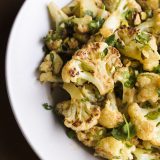The city’s sprawling Chinatown is a good start. But to truly appreciate just how intermingled Australian and Asian cultures are in Sydney, it’s best to walk the harbor, a perambulating cluster of rocky villi reaching into the Tasman Sea.
Start at the Opera House, where frequent ferries knock waves along brides maneuver their attendants for photo ops on the broad stairs stretching to the seashell-stacked building.
Finish several miles later at the Sydney Fish Market, seemingly plucked from Tokyo. It’s a menagerie of sushi and tempura sidled alongside local cheeses. Fish Market Cafe’s black rice doughnut sushi—a plump wheel of sticky rice, salmon, avocado, roe and barbecue sauce—makes a satisfying, if odd, breakfast.
Emanating out from this coastal track, spanning and infusing the city with flavor—a breathtaking array of Asian eateries seamlessly integrating themselves. Cambodian. Chinese. Sri Lankan. Japanese. Korean. Thai. Vietnamese. And on.
Around the walk’s midway point is Fujisaki, where a sleek black interior peers over the harbor through massive sliding glass doors. It’s where chef Joey Ingram imbues the ingredients of Australia and New Zealand with the flavors of Japan.
The menu enticed—fresh Tasmanian wasabi; rainbow chard with sesame sauce; baby corn with shiso; pork kakuni with eggplant and parsnip; Angus beef with hacho miso and a blend of local wild mushrooms; and cauliflower dengaku.
I expected little from that last one. Dengaku refers to glazing foods with a miso-based paste, often eggplant, tofu and daikon. I’d never seen cauliflower dengaku, but it made sense. It’s a neutral vegetable becoming of bold, rich sauces. But there you have it—a dish that’s little but a carrier for a sauce isn’t much of a dish.
One bite and I didn’t care. Robust cauliflower florets that were tender, but still toothsome, coated thickly with a deep amber jam, richly savory and subtly sweet. Crushed pistachios and sliced scallions were sprinkled over, sticking to the glaze and adding contrasting crunch and freshness. It was handily the most memorable part of an outstanding meal.
An obliging waiter walked me through the recipe. The glaze was simple—red miso, mirin, sake, honey and soy sauce—and the cooking even simpler. Toss cauliflower florets with the glaze, then roast, garnish and serve. To balance the richness of the glaze, they also gave it a finishing spritz of yuzu, a lemony citrus juice.
Back at Milk Street, we loved how the simple glaze transformed cauliflower. We made our version with white miso—preferring its lighter, sweeter flavor—with sake, honey and (in place of hard-to-find yuzu) unseasoned rice vinegar. We followed Fujisaki’s coating-then-roasting method, but got lackluster results. The coated cauliflower didn’t brown well, and the heat dulled the flavors.
To fix this, we borrowed a lesson we’d learned from another southern hemisphere country. We often wrongly assume the principal seasoning of a dish should occur before or during cooking. But sometimes you get the boldest, brightest flavors by adding it at the end, as with Peruvian escabèche, in which meat or seafood is doused with acidic marinades after cooking.
Adopting that approach, we roasted lightly oiled cauliflower florets until just tender and lightly browned. Once the cauliflower was ready, we simply added it to the glaze and tossed until well coated. A sprinkle of fresh herbs and chopped pistachios and—it turned out—the sauce really could make the dish.




